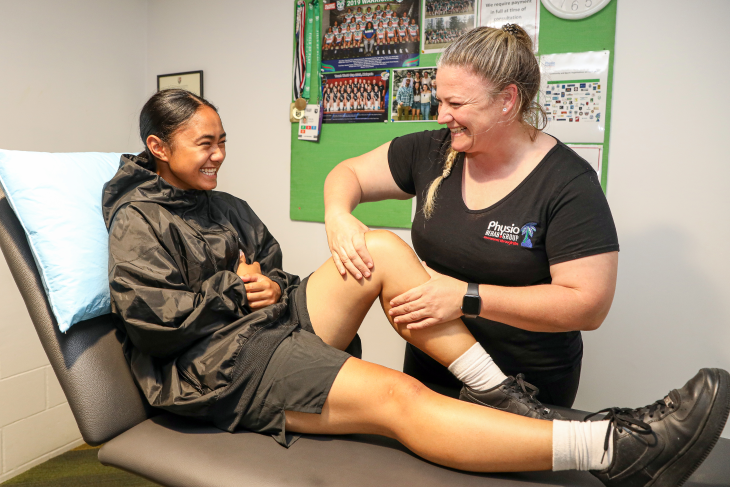How to make the finish line this summer Me pēhea te whakawhiti i te rārangi whakamutunga i tēnei raumati

One of Aotearoa New Zealand’s greatest ultrarunners is keen to see people hitting our roads and trails this summer but has some important advice to help you reach the finish line.
Across her 25-year career, Lisa Tamati competed in over 140 ultramarathons around the globe – totalling over 70,000km of running.
She retired six years ago and now guides over 700 athletes with her business partner, exercise scientist Neil Wagstaff.
Lisa says one of the most common mistakes people make when getting into running is to go too hard, too soon.

“I’ve dedicated my life to running all over the world – it’s one of the most rewarding sports you’ll ever get into,” she says. “But most runners don’t actually come to us until they’re injured. Everyone thinks running is easy. They think you just put one foot in front of the other and it’s a simple thing – you buy a pair of shoes and off you go.
“But that’s not the case at all. It’s a skill you need to work on and perfect.”
New Zealand’s largest fun run – are you in?
A holistic approach works best
Lisa believes the benefits of running go way beyond improving your fitness levels, especially in times of high stress.
“Getting out in the elements for a run is great for your mental health,” she says. “We need to be out in nature, in the sunshine and pushing ourselves. It’s part of our DNA and is hugely beneficial to our mental and physical wellbeing.”
But Lisa says chasing a running goal without proper planning is a recipe for disaster. She admits she didn’t train correctly for the first half of her career, until she had the guidance of a running coach.
“He changed everything,” she says. “Prior to that, my mindset was really strong but I really had no idea what the hell I was doing.”
That’s where Neil came in. He cut her training distances in half, replaced that with strength and mobility work, form drills and balance training, as well as advising changes to her diet.
“Having a holistic approach to your training is really important. You have to build that foundation,” Lisa says. “If you have that then you have permission to run the miles. If you don’t, then it’s like building a house on sand – you’ll get injured.”

Planning to go the distance
Lisa says it’s common for weekend warrior runners to sign up for a long-distance run without a plan. They try to cram their training in and end up injured and demoralised.
“Your fitness is really hard won. When you get an injury you’re back to scratch again, so preventing injuries is so important.” It’s worth it. Lisa says the feeling when you cross the finish line at the end of a long-distance running event is indescribable.
“When you achieve something like that, it lifts the horizons to what you think you’re capable of,” she explains. “It helps you be stronger and more resilient. You’ll then find yourself asking, what next? You know if you achieved that then you can take on something else, which carries over into other parts of your life.”
And not achieving the outcome you were hoping for is also far from a failure. “You’ve still done 100 times more than someone sitting on the couch,” she says.
“You’ve grown, learned and developed. There are times when I haven’t hit one of my goals but that was okay because I knew I was getting better.”

Challenge yourself with ‘Round the Bays’
New Zealand’s largest fun run – are you in?
There are many stunning and challenging running events taking place all over our beautiful motu this summer. But one of the jewels in the crown is Auckland’s famous ‘Round the Bays’ – the country’s largest fun run.
The latest instalment of this iconic event take place on 5 March in 2023 and will bring together over 34,000 participants. You can be there in person to run or walk the 8.4km course along the Waitematā Harbour’s picturesque coastline – or take part virtually from anywhere else in the world.
ACC is proudly partnering with Round the Bays to support participation and encourage everyone taking part to ‘Have a hmmm’ before they jump in.
Check out the below tips from Lisa to make the most of your Round the Bays experience, or to tackle any other running goal you have this summer.
Lisa Tamati’s injury prevention tips
Talk to a running coach
This ensures your programme is tailored to you, your lifestyle, age, injury profile and goals.
Shoes
Go to a store where the staff know how to fit running shoes properly. Shoes that are too small will cause blisters and shin splints. Also have the right shoes for your environment – trail or road.
Warm-up
Most people work eight hours and then just chuck the shoes on and run slow for the first few minutes. That’s not a warm-up. You’ve been in a sitting position all day, so your hip flexors have shortened and your hamstrings have overlengthened. You need to straighten everything and activate the muscles. A dynamic warm-up will improve performance and make running more enjoyable, not to mention reduce your chances of injury.
Strength/mobility/balance
Go to a gym if you can or have some basic pieces of equipment at home, like kettle bells and resistance bands. You can also use a TRX (Total Resistance Exercises) system and a foam roller or shakti mat. People don’t have time for a 1-hour yoga class every day but you do have time for 10 minutes of mobility work at home. Make it a habit. Do yoga, foam rolling and get a massage if that’s within your means.
Nutrition
Eat whole, unprocessed foods and don’t overdo the simple carbs. Avoid eating additives and preservatives. Getting your electrolyte balance right is important.
Warm down
Put aside time to stretch after your run. Build recovery days into your programme. The gains come during sleep and rest times, not during the actual training. Don’t forget that the next time you’re tempted to overtrain and under-sleep.





